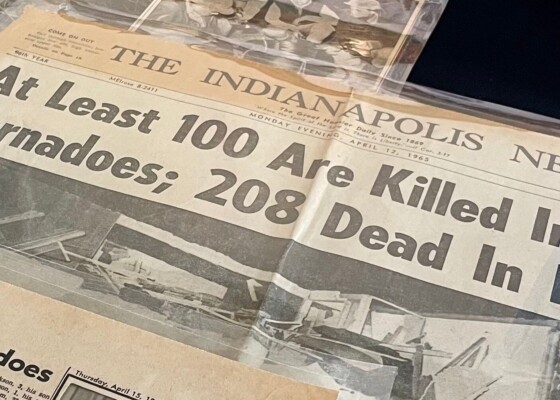Dreaming of the Dunes: A Campfire Overview
July 26, 2016Some days are mundane. We wake, do the usual, go to sleep. The Next Indiana Campfires event on June 18 was anything but mundane. As I pulled into the Dunes…
Some days are mundane. We wake, do the usual, go to sleep. The Next Indiana Campfires event on June 18 was anything but mundane. As I pulled into the Dunes Learning Center with my family and a friend of my daughter, the new and unusual had begun. Although I have been spending summers on Lake Michigan all my life, I had never heard of this delightful spot. Tucked back in the woods and wetlands that make up a large part of the Indiana Dunes National Lakeshore, I was impressed by this haven for preservation and education and felt a keen desire to guide a beautiful program that would inspire while highlighting the unique beauty of our state and of this region.
There are many Hoosier authors who have told tales of landscapes, people, and people in the landscape of this region. I hoped I had good selections to share with the people who were coming to do a guided hike of Cowles Bog Trail, readings to offer insight and new perspective (even if I had erroneously mapped a path that started at a different trail head). As everyone was assembled, I tried to meet as many as I could, introduce myself, thank them for coming, and hear what they were looking forward to seeing and doing. The 4.6 mile trail would be rigorous, so I figured that getting friendly and in good spirits first was important. Luckily, I had two park assistants – a naturalist from the Dunes Learning Center and a Lakeshore naturalist – who could help identify and explain the importance and significance of the ecosystems we would be exploring.
This Campfires exploration was going to be unique in a several ways: It would be long, rigorous, and anything but mundane. We would traverse a wide range of ecosystems, and see first-hand why dunes country is one of the most ecologically diverse in the country. Once at the trailhead, I shared some background on Henry Cowles, who, while not a Hoosier author, used the unique Indiana landscape of the Dunes as inspiration for ongoing studies that made him one of the most notable early ecologists.
As we began our ecological and philosophical journey, the sun was shining, a slight breeze was shifting grasses and leaves, a blue sky blazed overhead, and spirits and energy levels were high. The scenery offered a classic study in contrasts: to the left, power lines and industry in the distance; to the right, an expanse of fen. We read how, as Cowles described it, “ecology… is a study in dynamics,” and that by “burying the past, the dune offers to plant life a world for conquest, subject almost entirely to existing physical conditions.” This was clearly portrayed by the scenery, both natural and man-made.
I shared a few more observations by Cowles to introduce us to the landscape, but the facts sat cold on this warm and sunny day. It was time for a poem. I invited the hikers to close their eyes and open their senses, and shared “This World” by Mary Oliver. Her words invited us to see how fancy our world is – often a foreign thought to Hoosiers, who are too used to looking past the subtle and quietly diverse world in which we live.
I would like to write a poem about the world that has in it / nothing fancy. / But it seems impossible. / Whatever the subject, the morning sun / glimmers it.
After a few climbs, we stopped again to observe the world around us, and to hear excerpts from Edwin Way Teale’s Dune Boy: The Early Years of a Naturalist. This Hoosier author grew up in the dunes region, and his acute descriptions of systems and natural processes moved us all, brought us a new appreciation of change, and heightened our powers of observation.
As we watched the landscape change with, seemingly, every few steps, the blue sky shone on, the sun dappled shadows into the forest, and conversations began to focus more on details than of generalities. At the top of our final ascent on the way to the beach, we paused to read a few details from Cowles about dune and beach ecology, then plunged downhill through the sand towards lunch and beach grass and waves and lake-chilled breezes.
Once refueled, I took the somewhat necessary role of cheerleader: “See that sand dune? That is our last climb of the day! Yes, it is hot! Yes, it is tall! Yes, we will make it to the top!” Plus, I promised another poem at the top…
We all made it to the top, with renewed respect for sandy inclines and vantages points the dune gave us. We rested, and let Mary Oliver remind us that both the dramatic and ordinary scenes are worthy of getting lost in contemplation over, are worthy of study, and offer the opportunity to grow wise and to be delighted by the world we see if only we look and listen.
The return route was easy and meandering, and offered a reverse order review of the changing landscape we had passed through. This time, there were a few surprises: the large patch of wild blueberry bushes, the native pale pink wild rose, the giant ferns. As we neared the end of the trail, we paused once more to hear from one of my favorite Hoosier authors, Scott Russell Sanders. The passage from his “Wildness” essay, my son told me later, was his favorite. Sanders shifts perspectives from a broad perspective, then narrow; big, then small; and then, a spiritual call to action. He calls on us to pay attention, to see what, who, where we are and what we have done, and what we can do as conscious beings who can and should be moved by love. It seemed fitting, less than a week since the Orlando shootings, and at the end of a walk filled with big and small sights, sounds, and thoughts, to let his words carry our thoughts and bodies back to the bus, back to the Dunes Learning Center, and back into our lives.
“Wilderness destroys, to be sure, recycling whole galaxies, but on balance it creates, bringing new and complex forms into existence; and it has brought forth, in us, a creature capable of gazing back at the source….
We can make peace with the rest of creation, perhaps more easily than we can make peace with our own kind. Unlike humans, who seethe with resentment over past wrongs, the whales and wolves and rivers and woods hold no grudges. They answer our love with healing. What more joyful and promising work could there be than to help nurture and restore wildness? For that good work we have a powerful ally in wildness itself.”
Does this post have you dreaming of the Dunes? Join us for a shorter trek on September 10. Register here!
—————————————————-
Next Indiana Campfires is a unique way to connect nature, literature and Indiana’s Bicentennial. The program is supported by the Efroymson Family Fund, the Nina Mason Pulliam Charitable Trust and Pulitzer Prizes Centennial Campfires. Indiana Humanities is supported in part by Lilly Endowment Inc. and the National Endowment of the Humanities.
This post is written by Krista Bailey, one of our Next Indiana Campfires scholars. Krista serves as director of IU South Bend Center for a Sustainable Future. The post is part of the weekly blog series devoted to the initiative. Check back every Tuesday to learn more about Indiana’s great environmental literature, find out interesting facts about Hoosier stewardship, get all the latest program details and more.


